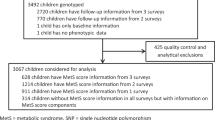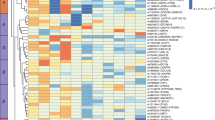Abstract
We identified a set of SNPs in the first intron of the FTO (fat mass and obesity associated) gene on chromosome 16q12.2 that is consistently strongly associated with early-onset and severe obesity in both adults and children of European ancestry with an experiment-wise P value of 1.67 × 10−26 in 2,900 affected individuals and 5,100 controls. The at-risk haplotype yields a proportion of attributable risk of 22% for common obesity. We conclude that FTO contributes to human obesity and hence may be a target for subsequent functional analyses.
This is a preview of subscription content, access via your institution
Access options
Subscribe to this journal
Receive 12 print issues and online access
$209.00 per year
only $17.42 per issue
Buy this article
- Purchase on Springer Link
- Instant access to full article PDF
Prices may be subject to local taxes which are calculated during checkout

Similar content being viewed by others
Change history
26 September 2007
In the version of this article initially published, the authors failed to acknowledge that recruitment of obese cases was supported by both Assistance-Publique Hôpitaux de Paris and Centre National de la Recherche Scientifique. This error has been corrected in the PDF version of the article.
References
Peters, T., Ausmeier, K. & Ruther, U. Mamm. Genome 10, 983–986 (1999).
Dina, C. et al. Science 315, 187 (2007).
King, D.C. et al. Genome Res. 15, 1051–1060 (2005).
Ott, J. Neurology 63, 955–958 (2004).
Hercberg, S. et al. Arch. Intern. Med. 164, 2335–2342 (2004).
Vu-Hong, T.A. et al. J. Clin. Endocrinol. Metab. 91, 2437–2440 (2006).
Le Fur, S., Le Stunff, C. & Bougneres, P. Diabetes 51, S304–S307 (2002).
Körner, A., Berndt, J., Stumvoll, M., Kiess, W. & Kovacs, P. J. Clin. Endocrinol. Metab. published online 20 February 2007 (doi:10.1210/jc.2006-2514).
Nyholt, D.R. Am. J. Hum. Genet. 74, 765–769 (2004).
Jacobson, P., Torgerson, J.S., Sjostrom, L. & Bouchard, C. Am. J. Epidemiol. 165, 101–108 (2007).
Stratakis, C.A. et al. J. Clin. Endocrinol. Metab. 85, 3396–3401 (2000).
Su, A.I. et al. Proc. Natl. Acad. Sci. USA 101, 6062–6067 (2004).
Acknowledgements
The authors thank M. Deweirder and F. Allegaert for DNA preparation and D.-A. Tregouet for discussions on statistics. This study was supported by the ANR Diabomics grant from the French National Agency for Research. Work on the German replication data set was supported by grants from the DFG (KFO 152: “Atherobesity”, project KO 3512/1–1 (TP 1) to A.K. and 1264/10–1 (TP5) to W.K.) and from the EC (“PIONEER” integrated project grant to W.K.). The Leipzig Schoolchildren project was supported by unrestricted grants from Pfizer Pharma and Novo Nordisk (W.K.).
Author information
Authors and Affiliations
Contributions
Contributions of each author are detailed in the Supplementary Note online.
Corresponding author
Ethics declarations
Competing interests
The authors declare no competing financial interests.
Supplementary information
Supplementary Fig. 1
LD in the FTO gene. (PDF 63 kb)
Supplementary Fig. 2
FTO gene expression in human tissues. (PDF 83 kb)
Supplementary Table 1
Assessment of putative functionality of SNPs. (PDF 40 kb)
Supplementary Table 2
Genotype distribution and association tests under the general and additive models. (PDF 43 kb)
Supplementary Table 3
Genotype counts, Hardy Weinberg tests and failed genotype rate. (PDF 36 kb)
Supplementary Table 4
Effect size estimation and quantitative trait associations. (PDF 42 kb)
Supplementary Table 5
Description of study populations. (PDF 32 kb)
Supplementary Table 6
LD with potentially associated SNPs. (PDF 38 kb)
Rights and permissions
About this article
Cite this article
Dina, C., Meyre, D., Gallina, S. et al. Variation in FTO contributes to childhood obesity and severe adult obesity. Nat Genet 39, 724–726 (2007). https://doi.org/10.1038/ng2048
Received:
Accepted:
Published:
Issue Date:
DOI: https://doi.org/10.1038/ng2048
This article is cited by
-
Molecular Mechanisms in the Etiology of Polycystic Ovary Syndrome (PCOS): A Multifaceted Hypothesis Towards the Disease with Potential Therapeutics
Indian Journal of Clinical Biochemistry (2024)
-
RNA modification: mechanisms and therapeutic targets
Molecular Biomedicine (2023)
-
Dietary approach to stop hypertension and healthy eating index 2015, modify the association between FTO polymorphisms and obesity phenotypes
BMC Research Notes (2023)
-
The contribution of FTO rs9939609 and RETN rs1862513 polymorphisms in predisposing resettled indigenous (Orang Asli) Temiar to metabolic syndrome
Egyptian Journal of Medical Human Genetics (2023)
-
Functions of N6-methyladenosine in cancer metabolism: from mechanism to targeted therapy
Biomarker Research (2023)



